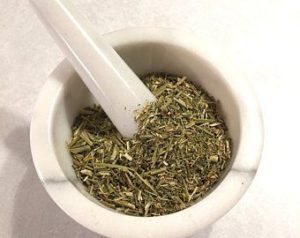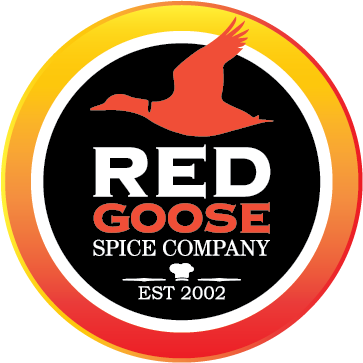Herbs and spices are simply amazing. Each one of them has a history and a story all their own.
Singularly, historians can trace back the origins and uses of nearly each and every herb or spice we use today, going back thousands of years
Commercially produced herb and spices blends however, are a much more recent thing. Often, the bi-product of convenience. Curry Powder is a good example. (See Red Goose Blog: Curry in a Hurry)
From ancient times, until a few centuries ago, you pretty much had to buy each and every individual herb or spice you used in your dishes. There were no “blends”. When it came to making a recipe with multiple herbs and spices, you pulled them all out of your pantry, added each one to your dish or ground them together in a mortar and pestle in whatever proportion you desired.

No Chili Powder, no Curry Powder, no “Italian” Herbs Blend, no Herbs de Provence.
Even if you love to cook, there are a couple of down-sides to making your own blends.
Besides needing to have all the individual components available (and fresh), each and every time you make a blend, there is the likely lack of consistency of flavor every time you make it.
As a result, herb and spice blends are, generally speaking, a very good thing. And each has a history all their own.
Take Herbs de Provence for example, one of the more unusual herb and spice blends.
Everyone loves a good story. This one however, doesn’t date back to ancient times.
Its name and the popularity of Herbs de Provence isn’t attributed to some famous French Chef, but rather to a popular American Celebrity Chef, who lived in France for a time and wrote one of the most widely known, and used, cookbooks on the planet.
Julia Child and her best-selling, Mastering the Art of French Cooking, first published in 1961.

This wildly successful book, considered by many to be one of the most influential cookbooks ever published, included a sauteed chicken dish using an herb and spice blend she named: “Poulet Sauté aux Herbes de Provence”.
The rest, as they say, is culinary history.
The usual suspects (plus one)
Before blends, and before Herbs de Provence had an “official” name, those who enjoy preparing the regional cuisine of Southern French needed to have these classic herbs and spices always at the ready, most of which, happen to be cultivated in Southern France. They are: Oregano, Thyme, Savory, Rosemary, and perhaps some Fennel, Tarragon, Bay Leaf, or Chervil if you are making one of the more unique blends.
There wasn’t, (and still isn’t), a “true” recipe for the exact proportions of each ingredient in Herbs de Provence however the earliest “recipe”, believed to be its ancestor, used nearly equal parts of just 4 herbs. Oregano, Thyme, Rosemary and Savory.
So, you just started there.
This blend, you might notice, lacked the one spice that everyone now identifies it by, and that is, lavender, which Southern France’s is famous for, and which both the locals, and tourists, love.
Lavender
It started to appear in later adaptations of Herbs de Provence and then became quite popular, especially in America.
Lavender gives Herbs de Provence its uniquely perfumed aroma, it’s alluring taste and adds a hint of French romance to what otherwise would be a blend which could just as easily be perceived as Italian.

A dish using Herbs de Provence is unmistakable in any recipe it is used in.
However, as the Herbs de Provence blend became more popular, even those in a professional kitchen, had to keep ALL of these individual herbs and spices in their pantry AND fresh, and then measure them precisely each time to obtain a consistent result. Oh, and by the way, lavender seeds aren’t exactly cheap, so unless you’re making this blend a lot, why would you want to have lavender seeds in your pantry?
Kind of a pain.
As expected, it didn’t take long for the purveyors of herbs and spices to seize the opportunity to provide various versions of an Herbs de Provence blend to both the retail and commercial markets.
So, just how is Herbs de Provence used?
Herbs de Provence is extremely versatile. It pairs well with chicken, pork, lamb, fish, vegetables, on salads, salad dressings, even omelets!
Recipes using Herbs de Provence include cooking methods such as sauteing, braising, grilling and roasting. It can be uses as a rub before cooking, added to a liquid or sauce during cooking or even as a topping to a salad or pizza.
Classically, beyond proteins, it pairs well with tomatoes, olives and olive oils, cheeses, root vegetables and many Mediterranean dishes which its why you’ll often see it used in Ratatouille, Tapenades and rustic vegetable stews. You’ll also find it gives off a remarkably fragrant smoke if you moisten it and sprinkle it over coals while grilling.
Whether you currently use Herbs de Provence in your cuisine or, you’d like to explore the amazing versatility of this amazing blend enjoyed by so many foodies on BOTH side of the “pond”, The Red Goose Spice Company has a marvelous version available for immediate delivery to your kitchens.
As Julia Child would say as she ended each and every one of her TV shows…”Bon Appetite!”

